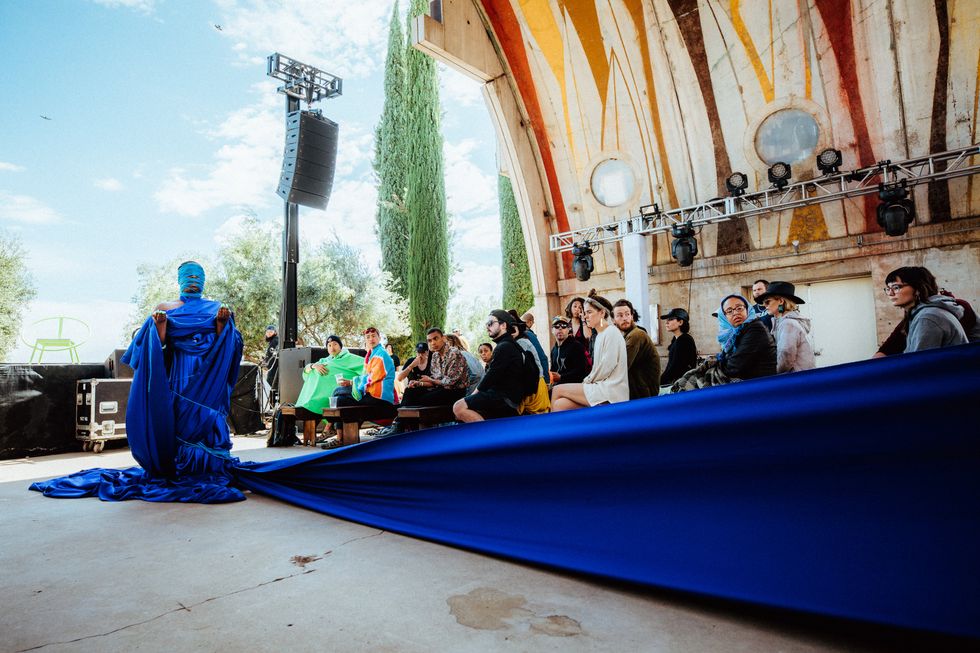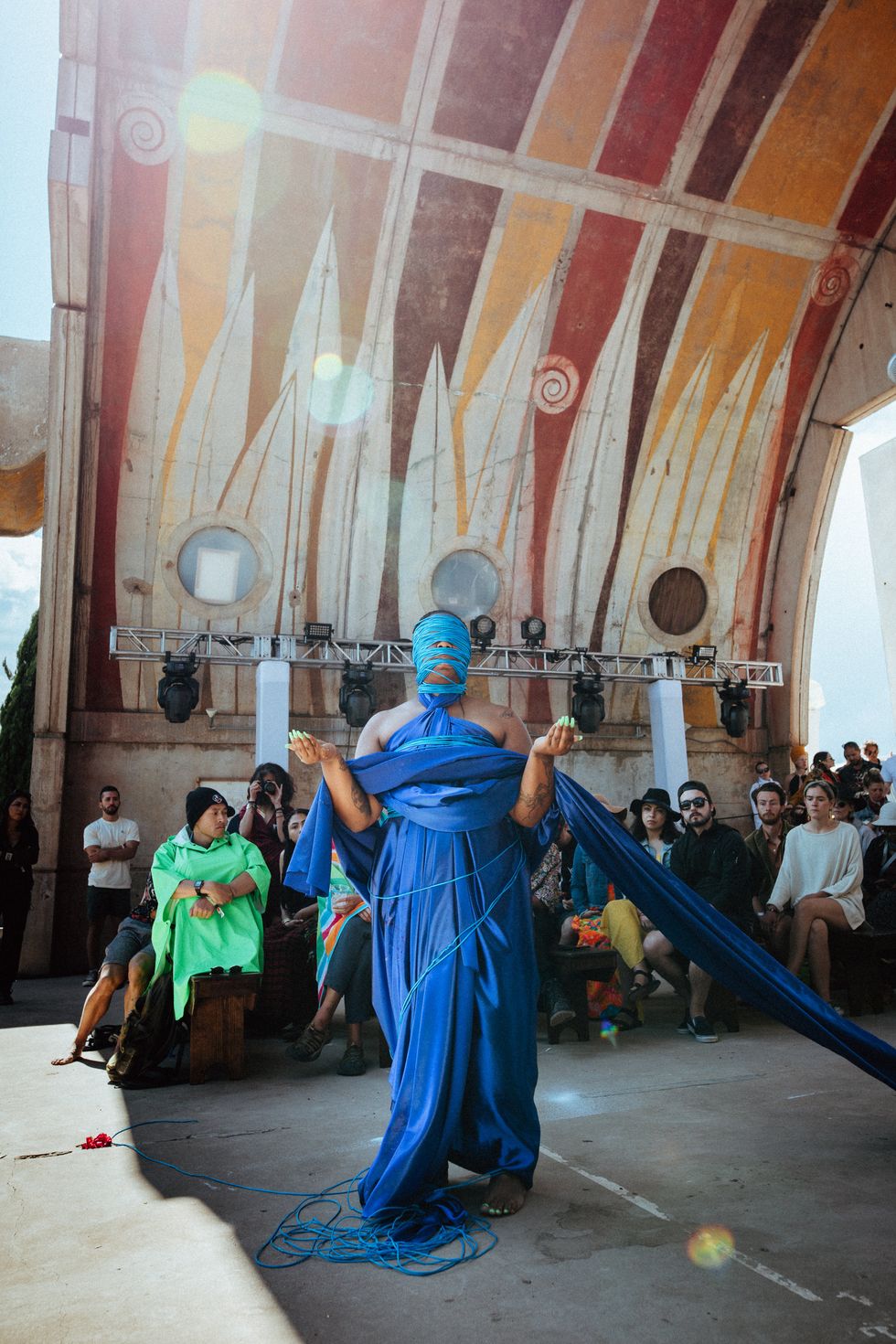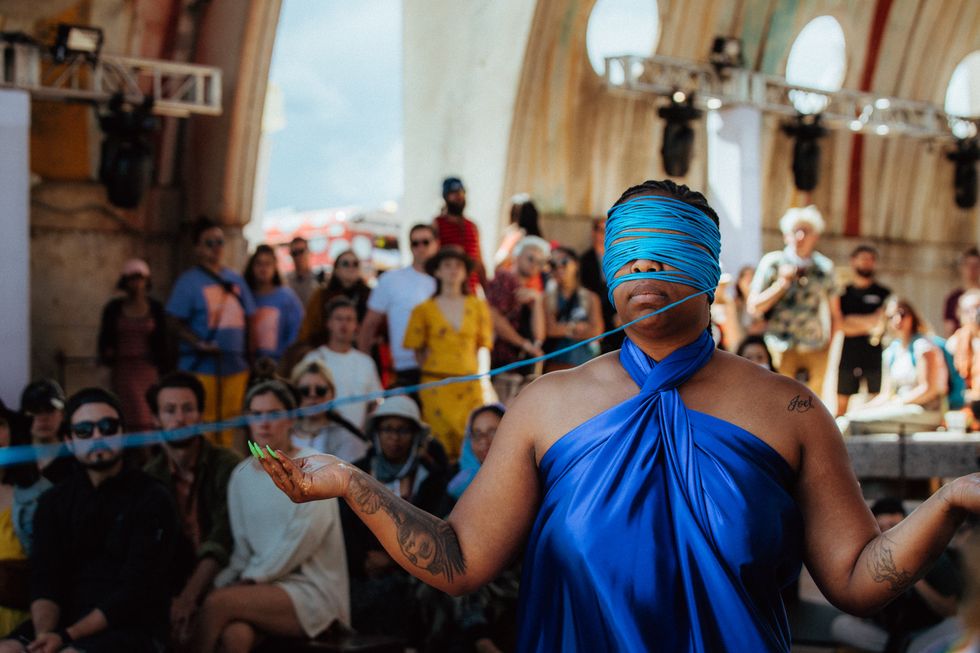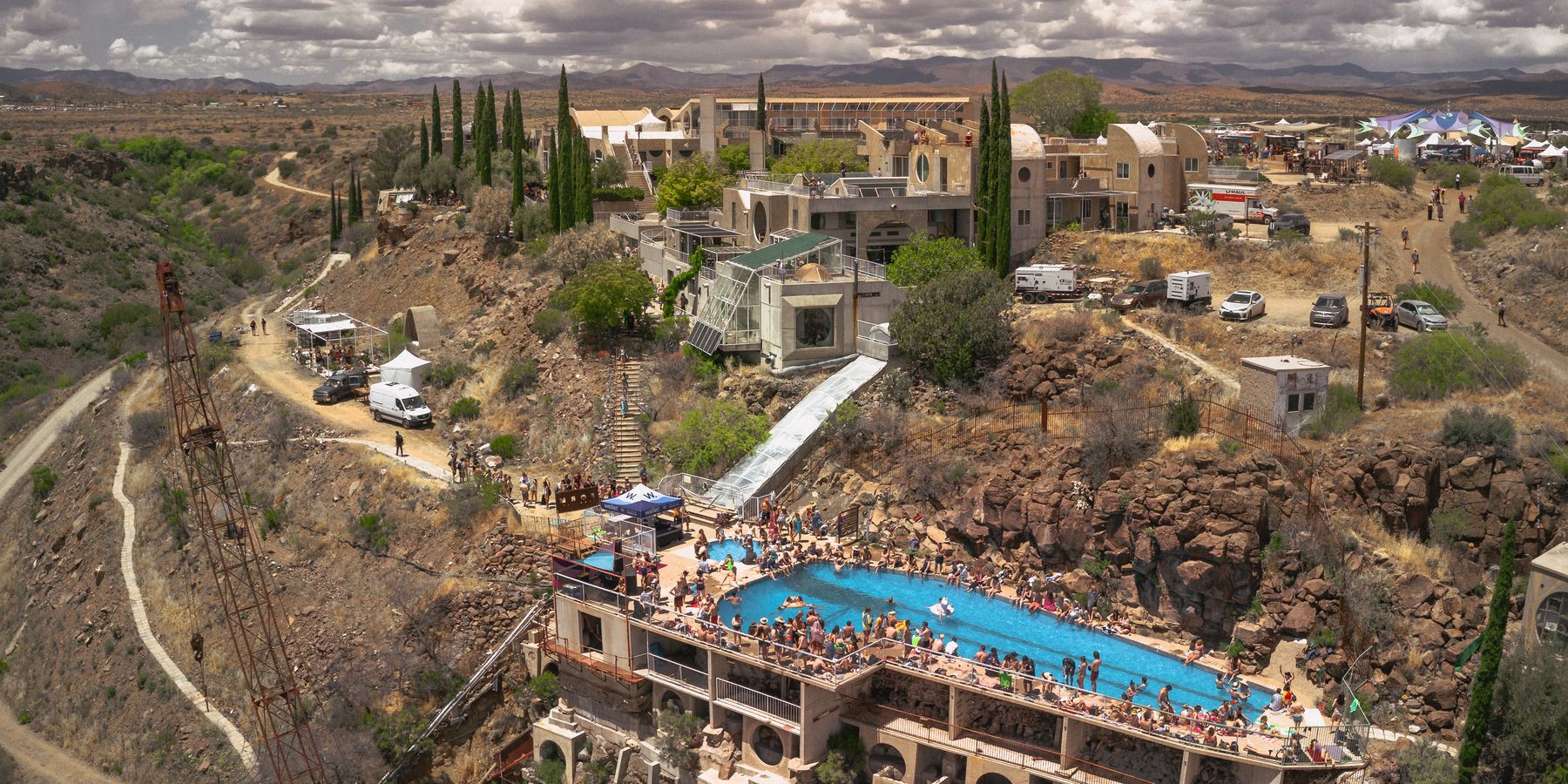
A crowd is gathered on pew-like benches under the 60-foot ceiling of a vaulted, open-air hall. Red, orange and yellow backgammon stripes paint a perpetual sunset on the pale arch. Sparrows flit in and out, occasionally shitting on unperturbed onlookers. As if at a wedding, everyone turns in their seats, transfixed, as Patrisse Cullors, one of the co-founders of the Black Lives Matter movement, walks barefoot down the aisle dressed in royal blue silk. Her face, neck and chest are mummified in twine, so only her nose and lips show. Her collaborator, Damon Turner, tugs the twine from across the room, gently spinning her while the casing unravels. Tipped with green acrylic nails, her hands are outstretched as if in holy reverie. Nipsey Hussle's "Victory Lap" blasts through the hall.
The scene is a performance art piece called "Knot," that Cullors debuted at this year's FORM music and art festival. After the last strand falls from her face, Cullors sits down to discuss the piece: how Hussle carved out pride and humanity for the gang-members Cullors grew up around, her shock at seeing a Black gang-member treated like an idol at his funeral, her choice to perform in Crip blue, and the importance of engaging with grief.
Cullors' piece is loaded with violence and tension that seems like it would be in conflict with sunny festival bliss. But as people call out responses to her queries, and form a long line for the Q&A, the scene feels more like a university seminar than a music festival (minus the cyprus trees, distant mesa, and occasional bikini top in the crowd.) Cullors is on the academic end of FORM's genreless line-up, which this year was topped by Florence and the Machine, Anderson .Paak, Kaytranada and Skrillex, and filled out with a mix of avant-garde experimenters (Serpentwithfeet, Kelsey Lu), indie darlings (Snail Mail, Japanese Breakfast, Miya Folick, Sasami) and global legends (Pussy Riot, Vieux Farka Touré). However, there's a sense that this — Cullors speaking, her face still lined by the rope, about grief and bondage — is what people came for, as much as fist-pumping to DJ Koze or clapping along to Florence.
Perhaps, at FORM, attendees are primed for openness and deep engagement, because if you pay attention to your surroundings, they'll make you question everything you know.
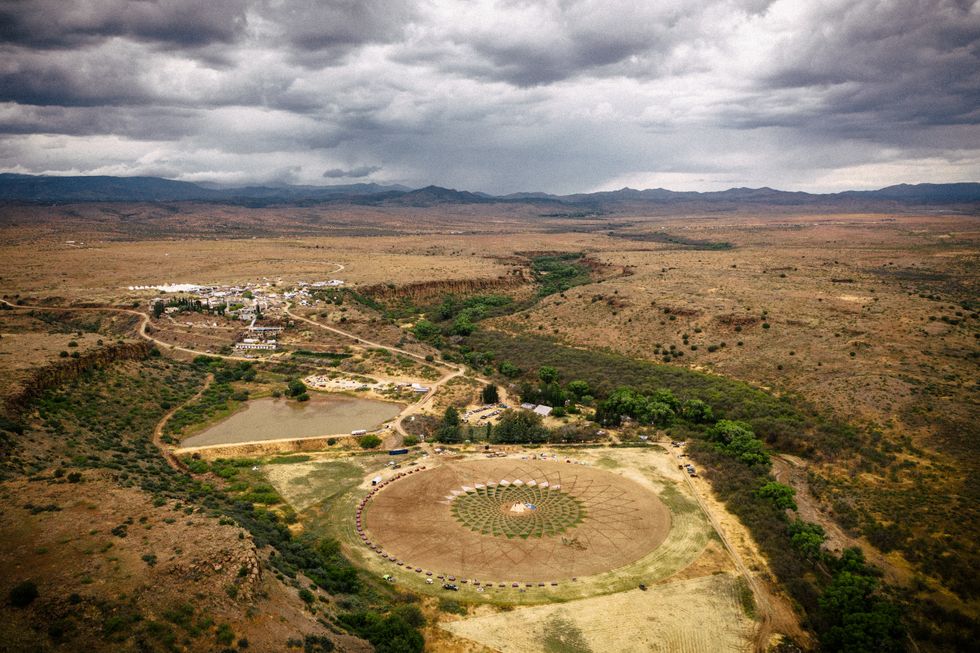
Photo: Saam Gabbay
FORM exists because of Arcosanti: an architectural fantasia hidden in the desert an hour outside Phoenix, Arizona that can make anarchists and architects alike wax poetic. Founded in the 1970s by renegade architect Paolo Soleri, Arcosanti was his laboratory for "arcology," a union of architecture and ecology that manifests in a human (rather than automobile) scale of building and urban planning, inspired by nature's compact, self-sustaining systems.
The weekend's concerts and workshops are hosted throughout Soleri's multi-node citadel atop a desert mesa. It's hard to pin down if it looks more ancient and futuristic, fantasy or sci-fi. With it's central amphitheatre, Cyprus tree promenade, swirly motifs, quasi-religious silhouettes, and porthole windows, Arcosanti looks like a bricollaged Grecian palace, celestial observatory and beached spaceship.
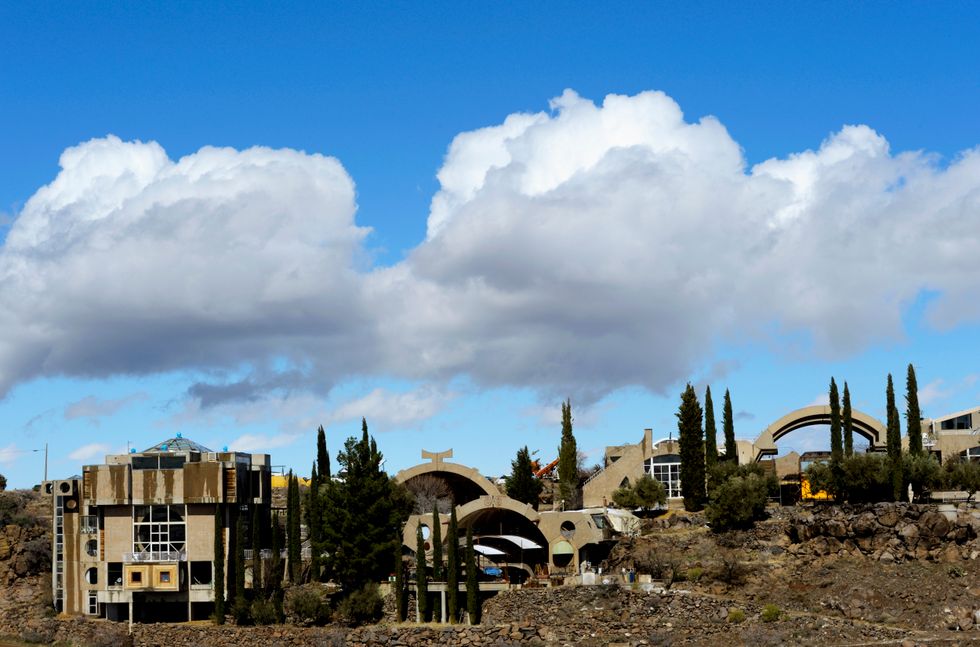
Photo via Getty
"The architecture of Arcosanti informs the intimacy and vibe of the festival. There's something really special about watching and participating there," says Aja Monet, a Brooklyn poet and organizer, performing for her second time at the festival. "It's not just another venue. It's an actual community."
Arcosanti isn't decorative. Soleri imagined arcology as an answer to the gas-guzzling urban sprawls where most Americans live. Built from natural materials, carless, and passively cooled, Arcosanti is a sustainable utopia. Beyond slowing the destruction of the planet, Soleri, a romantic, thought arcology could even save our souls. He felt that the mindful, collective, and intimate lifestyle encourage by Arcosanti's close quarters could remedy the disease of late capitalist individualism and alienation. Soleri died in 2013, but today, around 80 people live and work full-time at Arcosanti, living out his vision.
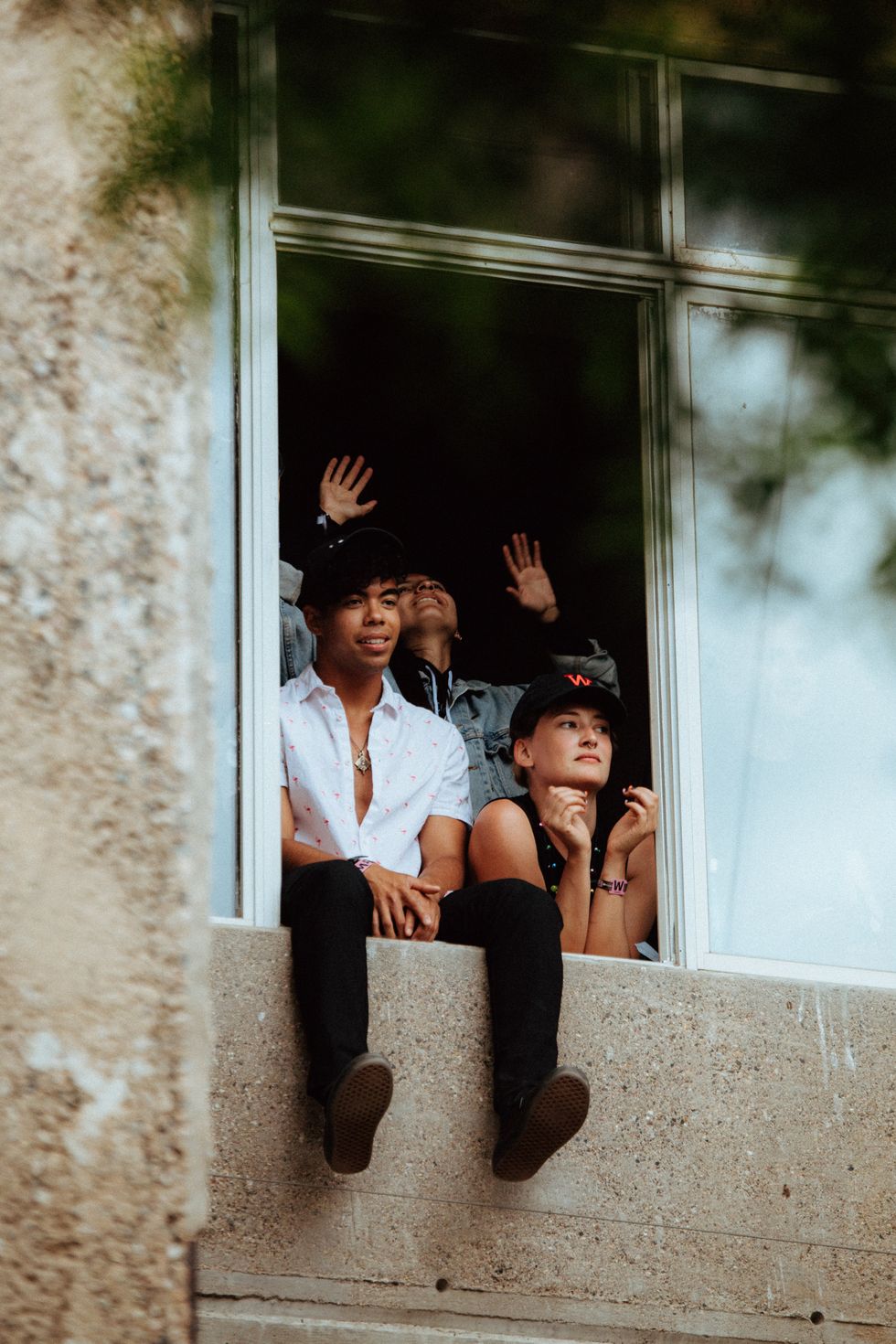
Photo: Quinn Tucker
"Our mission to the public is to serve as an example of an alternative," says resident and Director of Planning, Kevin Pappa. "If we want to continue to inhabit this earth, we have to change the way we inhabit it. That means redefining our collective priorities. We need to live with less impact on our environment, and more of an impact on the consciousness of each other."
Providing a home for experiences like FORM fits into the future Arcosanti is trying to prove possible. "It is surreal to have world-class musicians serenade the apartments that open into our amphitheater," Pappa explains. "But the resurgence of the renaissance is what life at Arcosanti has revolved around since its inception. For most of the world, arts and culture are commodities and recreations. At Arcosanti, they are civil duties."
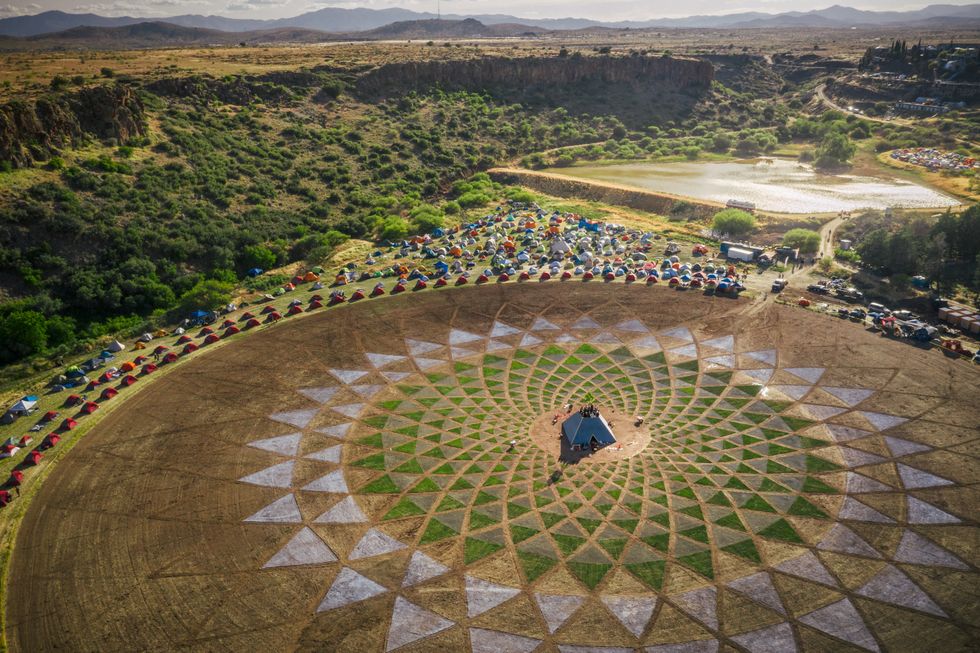
Photo: Saam Gabbay
Despite its grand ambitions and flowery language, there's no preachy evangelism at Arcosanti. You don't have to drink any Kool Aid for the place to plunge you into a fantasy, or for its principles to jostle some of the assumptions of your daily life. Arcosanti makes its point by simply leaving its doors open.
Elia Einhorn, a host of Talkhouse Podcast, is on-site recording sessions and interviews with artists in a makeshift studio in the bowels of Arcosanti. He describes the festival as "a slow-food movement approach, that strikes me as a conscious response to America's sinister 'always on' cultural shift…. FORM works to temporarily slow us down to be more connected to our surroundings and present in the moment."
In turn, FORM interpolates many aspects of Arcosanti's radical spirit into the weekend. Of course, plenty of people just show up expecting a great party in the desert. But Arcosanti's landscape has the uncanny ability to jolt the cynical and the unsuspecting into a state of wonder.
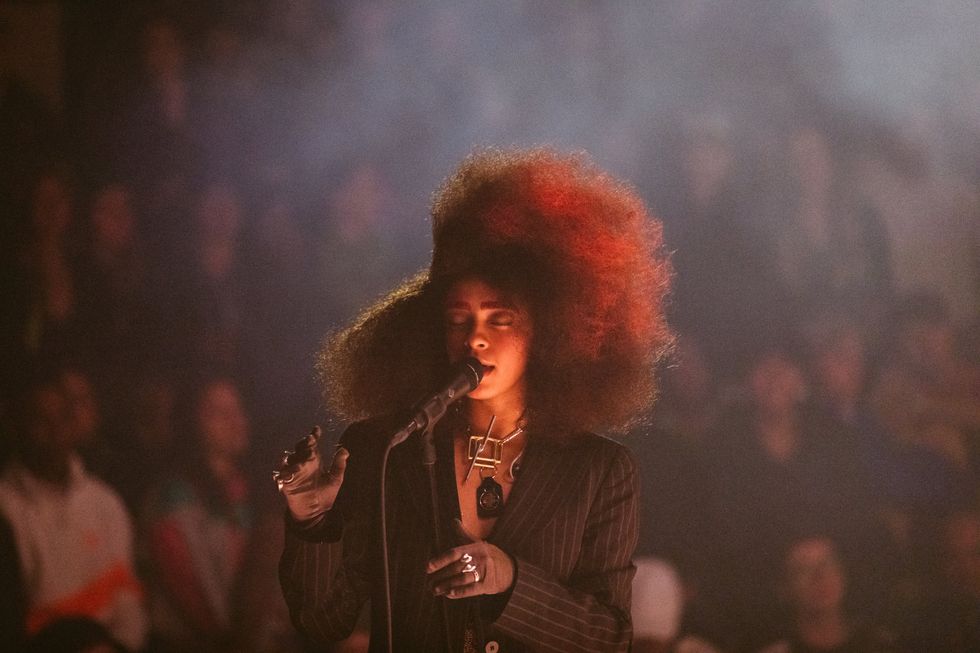
Kelsey Lu / Photo: Elli Lauren
Once Arcosanti shocks you awake, FORM slows things down. Attendees camp in the valley, pitching their tents in rings around a colorful landscape installation by Jim Denevan, that resembles a sacred crop circle. Each day, they awake at the foot of a mesa, and trek up to the castle where they spend the afternoon wandering the paths and tunnels linking the festival's three stages, the cafe-visitor center, the pool (open to all), and skyline of roofs and terraces. Between acts, people wander the cliffside garden's cornucopia of art installations, food trucks, and wellness stations, like a yoga tent and a sound bath: a fleet of giant beanbags sonically fenced in by jungle-noise-emitting speakers.
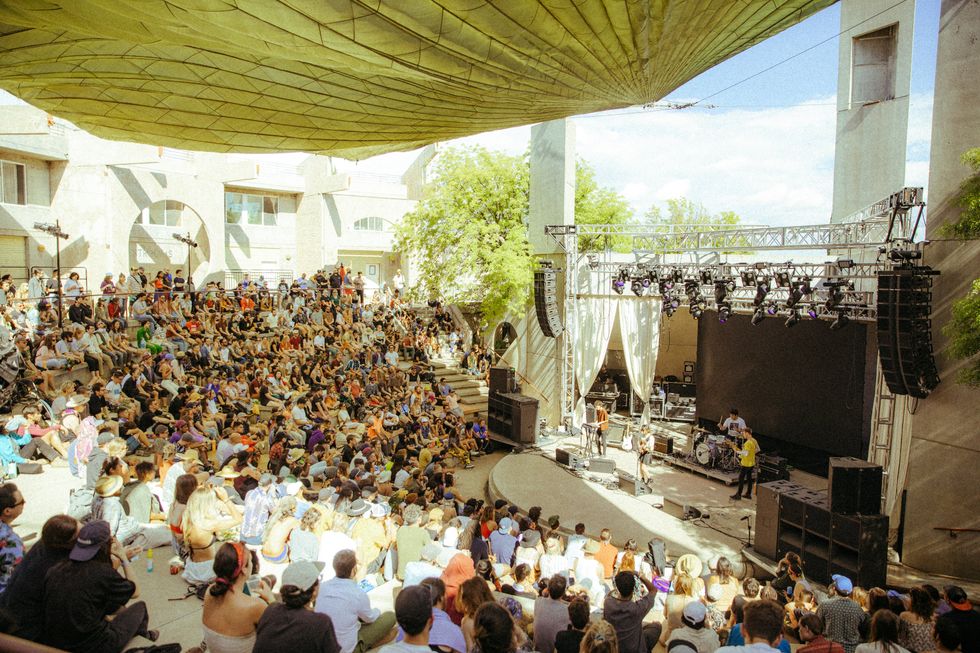
Snail Mail / Photo: Pooneh Ghana
During the day, people set out blankets in the amphitheatre to watch the acts cycle through. "It's really cool how the artists don't overlap," says Tony, a Miami musician and festival veteran attending FORM for the first time. "It puts the whole audience on kind of the same trip. At other festivals, some people are having the dubstep experience, some people are having the acoustic experience. Here, the whole audience is together."
At night, the vaulted hall where Cullors performed and lectured, becomes a strobe-lit dancefloor, where DJs like Peggy Gou and Bonobo work their magic. People take breaks from dancing to hang out on the cliff face, watching the psychedelic light displays projected onto the canyon.
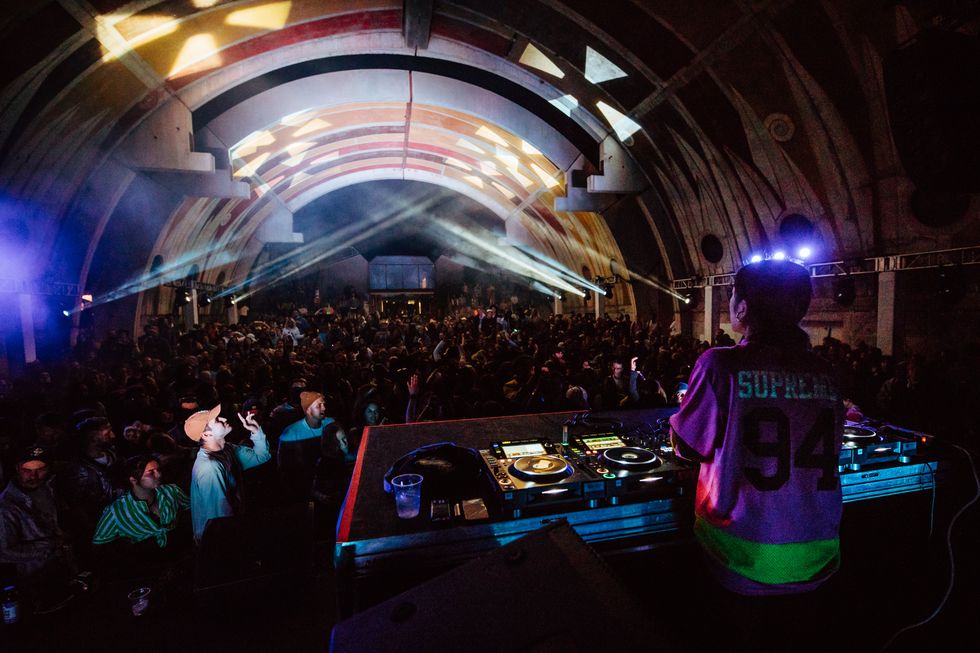
Peggy Gou / Photo: Quinn Tucker
Adding to the fantasy, FORM is largely free of anthropocene flourishes. Though there are occasional cloying signs of wellness culture, and logos like Equinox, Stumptown Coffee and Ketel One, most of FORM's partners, like Patreon, Vero and Matchabar, aren't the typical corporations that underwrite festivals.
Festivals need sponsors to run, but Arcosanti liberates FORM from other industry standards. Zach Tetreault, the drummer for Hundred Waters, started the festival as a glorified house show in 2013, after seeing Arcosanti on a road trip with a friend. The site's allure allows him to disregard marketability when curating the show's line-up, and book acts like Florence and Anderson .Paak that would typically never play to a 500-person venue like Arcosanti's amphitheatre. "I've never once pulled stats or sales on an artist," he says proudly. "If we think something is good, we pursue it."
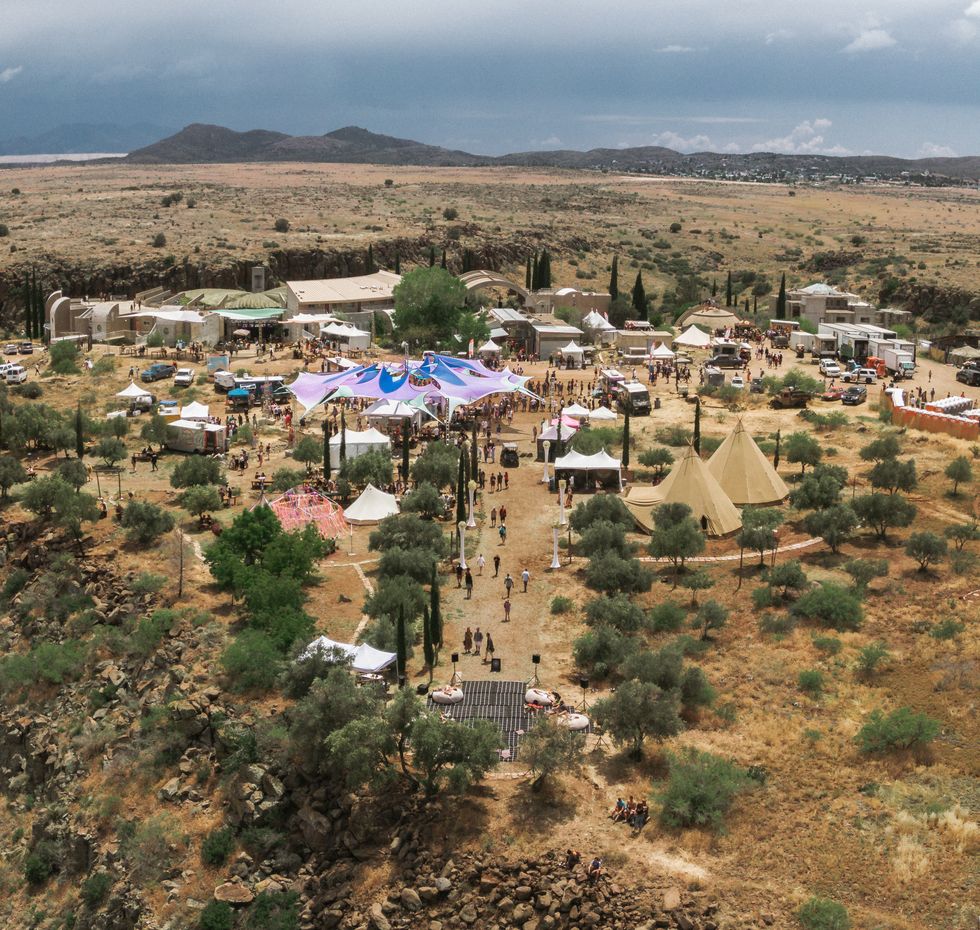
Photo: Saam Gabbay
The surreal landscape frees artists as much as fans, leading to priceless moments. "There's a willingness to get weird and personal there that you'd never see now at traditional festivals," says Einhorn. "Serpentwithfeet performed a largely improvised set that was one of the best things I've seen this year. We hosted backstage jams between Fred Armisen and Snail Mail, and then Robert Glasper with Vieux Farka Toure and Lonnie Holly, all on the same day."
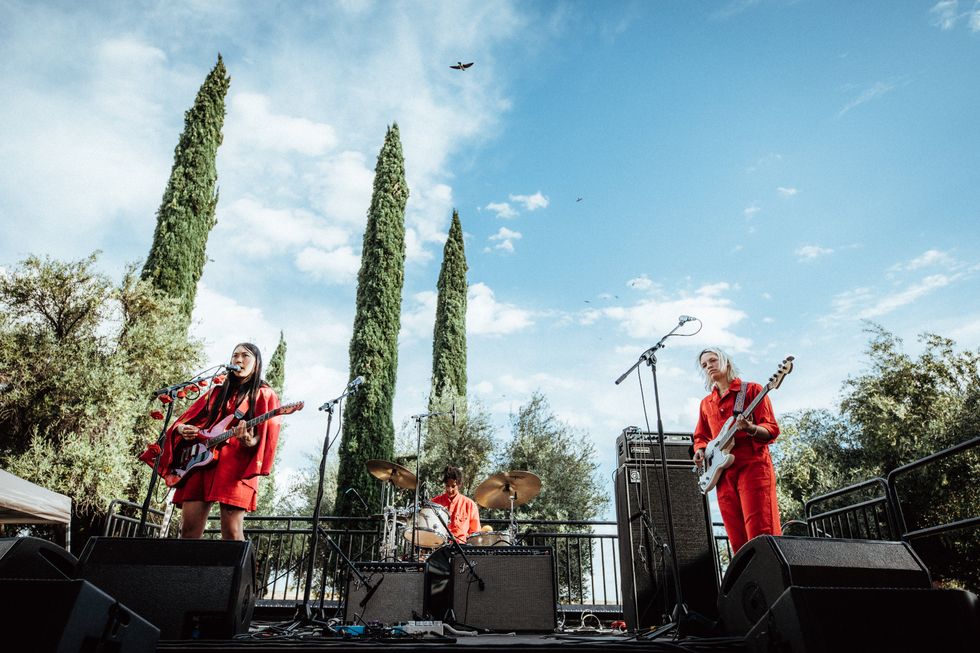
Sasami / Photo: Quinn Tucker
The tiny stages aren't just about the view. "FORM demands more intimacy and vulnerability from artists," says Monet. "It's not about going up on stage and just performing but about meeting people and feeling where the pulse of the future is."
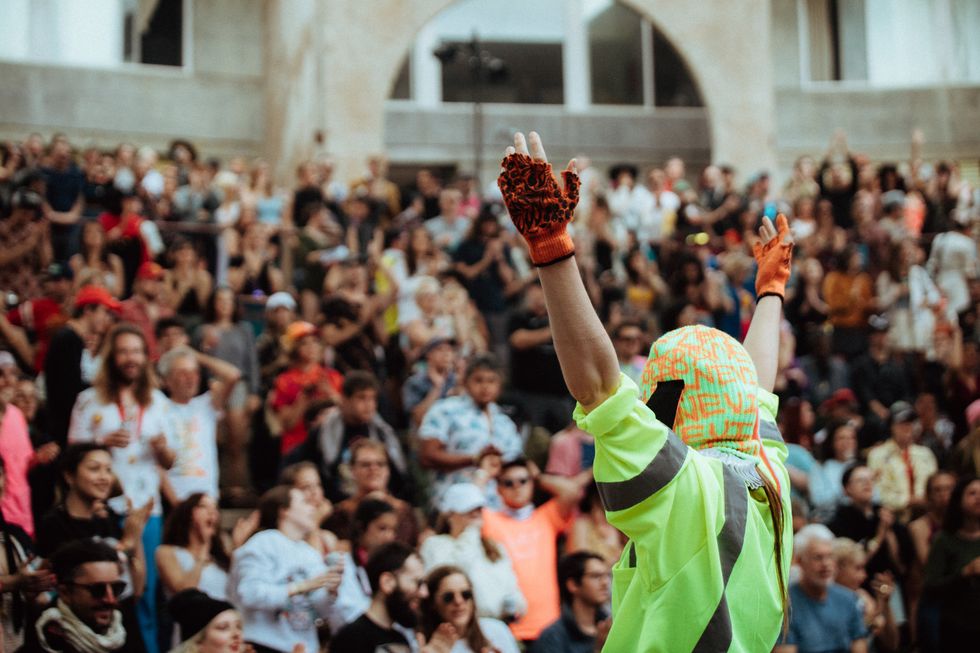
Pussy Riot / Photo: Quinn Tucker
While the music of FORM is inspired, the festival's greatest gift might be the space it creates for discussion. Aside from Cullors, poets Monet and British spoken-word bard Yrsa Daley-Ward became thought-leaders over the weekend, opening vital conversations with their electrifying performances, and continuing them at the panels. Daley-Ward discussed bodies and revolution with Florence Welch and Pussy Riot's Nadya Tolokonnikova for a book-group on the poet's The Terrible and the activist's Read and Riot. At panels on art and labor and fostering counter-cultural spaces, Monet challenged the crowd to resist society's marginalization of artists, and challenge the liberal notion of "safe spaces," instead employing a more realistic notion of "safer spaces."
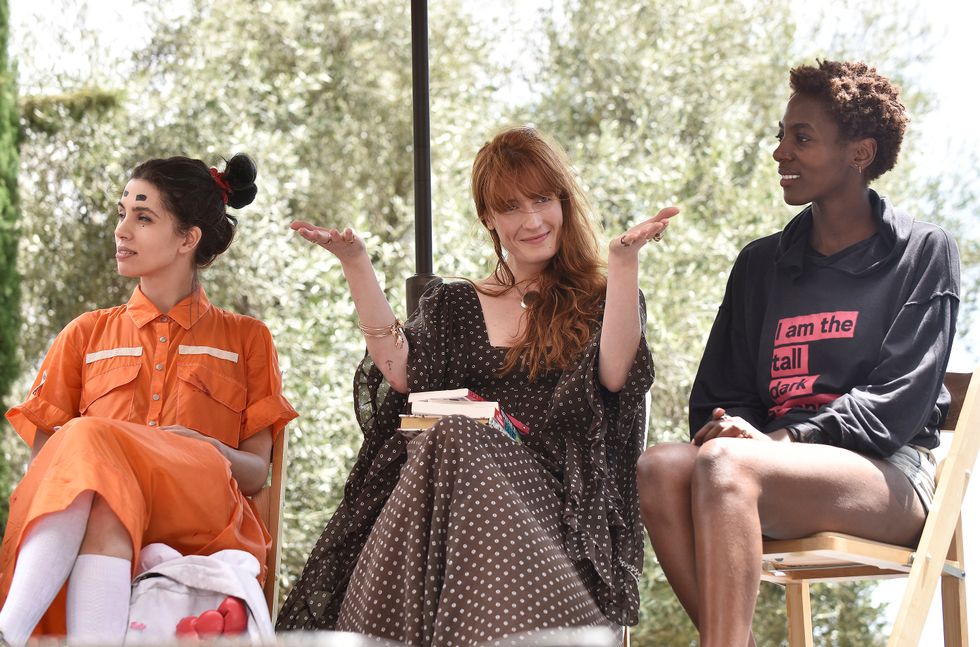
Nadezhda Tolokonnikova, Florence Welch, Yrsa Daley-Ward / Photo via Getty
Festivals are inherently escapist. We go to them to wear costumes and do socially unacceptable things like be kind to other people in public. In a certain sense, none offers an escape more total than FORM's. However, while the weekend is full of easy pleasures, like seeing your favorite artists up close and sipping cocktails at a cliffside sunset, the word "escape" evokes an emptiness that doesn't describe FORM. The surreal landscape's transportive capacity doesn't put attendees in a day-drunk stupor. Instead, it opens up a mindset, that FORM takes advantage of to nurse artistic discovery and challenging conversations, that have implications for life after the weekend.
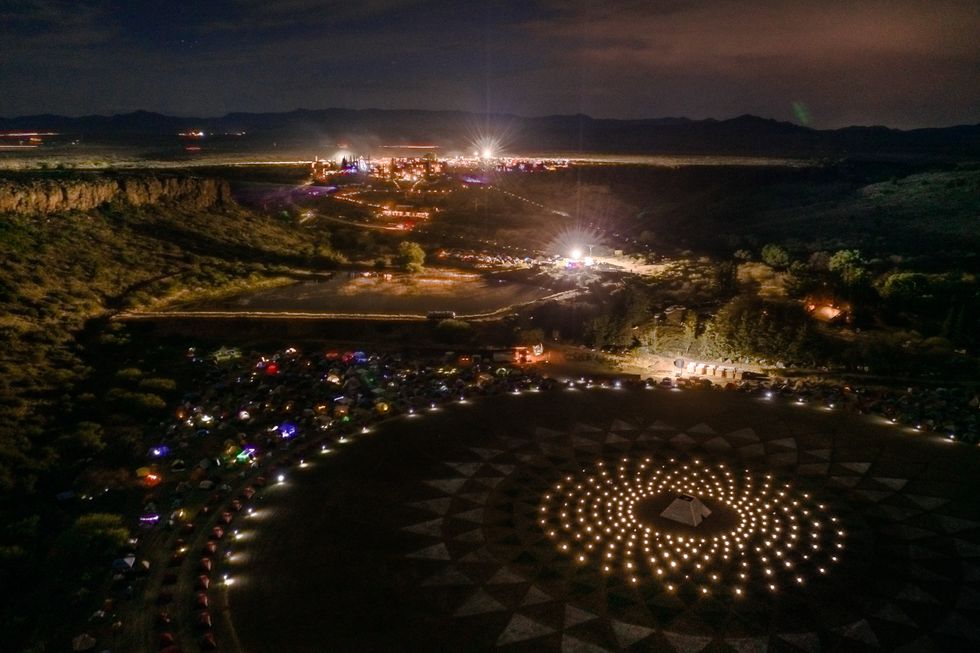
Photo: Saam Gabbay
"Festivals should not be about escape but a place for inscape" says Monet. "It's the vision and dream of community. How will we be accountable to each other beyond this festival?"
Papas promises, "You don't have to live in an arcology to change your life, and redirect your own community."
Lead photo: Saam Gabbay
From Your Site Articles
MORE ON PAPER
NSFW
Emily in LELO-Land: Your Fave Luxury Toy Brand and Your Fave Fashionista Unite
Story by Zandile Blay
